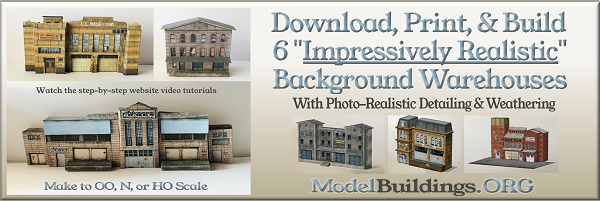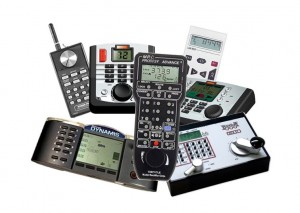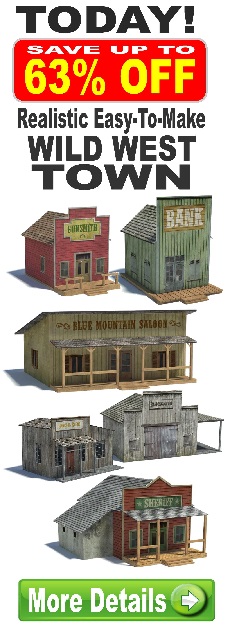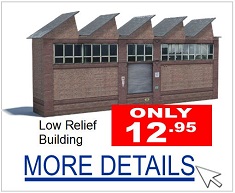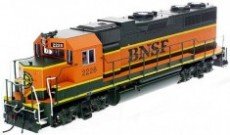Everything on model trains, model railroads, model railways, locomotives, model train layouts, scenery, wiring, DCC and more. Enjoy the world's best hobby... model railroading!
In the Dark With Tunnels? 5 Quick Tunnel Tips
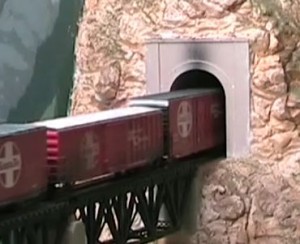 Model train tunnels are generally a necessity on mountainous layouts, but they can also add greatly to the realism of a scene.
Model train tunnels are generally a necessity on mountainous layouts, but they can also add greatly to the realism of a scene.
A tunnel is an excellent device for making a model railroad seem to be much bigger than it actually is. A tunnel will hide the train for part of its journey, leaving the viewer to imagine it has departed the area for a distant destination. When the train mysteriously reappears out the other end of the tunnel, it is easy to imagine it’s a completely different train coming from somewhere else. When model trains are constantly in view, realism can suffer.
Here are 5 quick tips for better tunnels:
1. Blacken the insides of your tunnels. A flat black acrylic paint can be used for the interior roof, walls, and floor. An unpainted “plywood-colored” tunnel interior will look unnatural, and lack the dark and mysterious appearance of a real tunnel.
2. Place ballast on both sides of the track inside your tunnel portal. Continue the ballast for as far as the eye can see.
3. If you are not experienced with making your own tunnel portals, they are reasonably inexpensive to buy. Ready-made tunnel portals sometimes are pre-weathered, but you can add your own weathering effects with gray wash, chalk etc. to add more realism. Smoke and exhaust smudges look good towards the top of the portal. Ready-made portals are certainly more realistic at the entrance to a tunnel than is a roughly cut hole.
4. Allow plenty of clearance inside the tunnel for your longest and tallest trains to navigate safely. There also needs to be adequate clearance for track and trains to the left and right of tunnel entrances. Although this won’t necessarily stop all derailments, it will ensure your trains don’t come to a sudden stop each time they try to enter the tunnel. Also, you’ll want enough space to put your fingers, or a tool (pair of long forceps or tweezers) inside the entrance if a train derails.
5. Allow access to the tunnel interior, because you can almost guarantee your trains will want to derail in the most hard to reach location on your layout, especially inside tunnels! Derailed trains can usually be retrieved easily from inside short tunnels, but longer curved tunnels can be problematic. This is why creating another access point is a good idea, either from underneath the track, or through the side of the mountain. Another option is to make your mountain (or tunnel) as a lift off section.
One quick idea is to build an old photo frame into the scenery. Chuck out the glass and use the frame and backing (face down), in the scenery. When a train derails you simply remove the backing sheet of frame to access the inside of your tunnel. You can hide the frame using bushes, trees, fences, or other scenery props.
25 Years Using DC… Is DCC Conversion Difficult?
Eric asks readers for advice:
“I have an old DC layout I built about 25 years ago and I want to drag it into this century technology wise. How much new wiring will I need to do to convert to DCC considering that I currently have various blocks I use to control trains in the different sections of my layout. Will I need to remove all the blocks, and make it one block instead? Also, will I need to buy new DCC equipped locos, or can my old locos be converted?”
Interesting Railroad Facts
This short 50 second clip presents some amazing facts about railroads in a fun way. Enjoy!
If you haven’t yet grabbed the free sample building mentioned in the clip, you can download it here.
Snow Plows In Action Close-Up
It’s late November and Winter has already announced its arrival in many countries in the northern hemisphere. This short clip shows a “snow-blower” train in Romania plowing a route through DEEP snow. The train actually derailed a couple of times on this section and needed a huge crane to lift it back on the track.
Meanwhile in the southern hemisphere Summer is on the way, and the iconic Ghan Tourist Train travels every week through central Australia in temperatures around 100F (35C). What a contrast!
Decoding the Decoder Space
Which DCC system is the best?
Most in the hobby have their own personal preference with regards DCC systems. There is a variety of brands (manufacturers) available, and generally most of them are very good. In many situations it just boils down to price, brand preference, and/or individual requirements.
After finally deciding to use DCC on your railroad, and carefully choosing your command station manufacturer, you’re not quite finished with the selection options. It’s now time to decide exactly what train or accessory functions you’ll want to control using your new DCC system. And, that’s one of the big advantages with DCC. With DCC control you will be able to select from a countless range of decoder hardware to meet your requirements regardless of the manufacturer.
Are NMRA standards necessary?
The NMRA standards have established the guideline so virtually any brand of decoder will operate with any compatible command station. Although some manufacturers do supply additional capability that is unique to their products, for the most widely used command station/decoder functions, all decoders have compatibility with all command stations if they are NMRA compliant.
How do decoders work?
Each decoder is like a brain in a DCC system. Decoders interpret each command that goes on the rails, and performs some action such as setting the locomotive direction or speed, or perhaps turning on lights. Decoders are separated into 2 general types; fixed and mobile, or accessory decoders.
The mobile decoders can also be broken into 3 sub-categories: sound, function, and a combination sound/function. Continue reading more on DCC decoders here…
Why Does My Train Keep Stopping?
Val asks readers for assistance:
“I am having problems with my OO train engine it keeps stopping on the track for no reason. It will go round without stopping then the next time it stops in different places all round the track. Can you help and tell me why? Thanks.”
Choosing the Right Scale
George has a question that most beginners in the hobby ask:
“What Scale do I pick …there are so many scales of model railroads that it is difficult to select which one? I favor the Old West …what is the best Scale for it?
You can add your comments to assist George with getting started.
Hinged Track Section
Bernard submits his question for readers:
“I would like to build a hinged section of track to open to allow me to get into the middle section of my O layout where all the controls are. I have an 8 x 12 layout in an upstairs room. Also would like to find a layout program for tracks, curves and switches, etc. Any suggestions please.”
Track Wiring And Sub Roadbed
Article kindly supplied by Kevin C:
When I have completed drawing the full-size layout track plans I want to use and before I lay out the track, I will generally decide the signal and switching locations. I’ll mark them on a plan. I’m planning road crossings so I’ll need to have the crossing light switching at the right location. Then, I’ll draw the wiring circuits onto the plan using different colors, as it is not hard to miss a connection or two when laying out the track.
Recently I was kindly given some computer data cable with four pairs in these color… Continue reading article and view full-size diagrams
Tunnel Derailments
Cliff is having derailment problems and needs advice from readers:
“My HO RR has a curve in the tunnel, but it is causing me no end of problems.
The trains run okay from one direction, but derail when running in the opposite direction. Small trains seem to operate ok but the bigger one’s are a real problem. Really annoying. The tunnel is a little hard to access but I have been able to alter the curve a little but the problem is still there. I desperately need help from someone please.”
Train Around The Chistmas Tree
Matt asks readers:
“I’m a beginner with model trains and was looking for a recommendation for a model train that I could put around my Christmas tree. I’m hoping to add a new car each Christmas so was looking for something where I would still be able to purchase new cars in the future. Thanks”
DCC Wiring and Diagrams
When you look at installing a DCC (Digital Command Control) system, there are typically two scenarios which exist. Firstly, you might be designing a brand new train layout, so can plan the layout design and operation before you put down any track. The other scenario is you could be converting your existing layout from DC to DCC.
For most railroad modelers, the first stage in the process is deciding which DCC system is right for their layout.
However, equipment control features shouldn’t be the only consideration. DCC systems typically operate in the same way, in that they send command instructions and power to the decoders via the track rails. That one important concept will decide how efficiently the DCC layout, in fact, ANY train layout, performs.
How to Wire Power Districts
DCC power stations will typically provide up to about 5 amperes of current to operate locomotives, with each one needing from (for HO-scale) between a half an amp and one amp. Read complete article and see full size wiring diagrams…
Ideas for Lift-Up Sections Wanted
New member to the club Jason asks readers for advice:
“I am in the process of constructing my HO layout using flexitrack and would like to incorporate a couple lift-up track sections on slides or hinges for easy access. I would be grateful for any ideas people have”
Add your comment to assist Jason.
If you would like to ask a question for publication on the blog, please use the special link in the right column. Please note: only the best (well-worded, well-thoughtout) questions get published. Please include clear details and check spelling etc before submitting your question to the blog moderator for consideration.
Make a Wild West Street Scene or a Small Country Town By Adapting These New HO, N, and OO Scale Models
JUST RELEASED!
A new series of western buildings for a Wild West street scene has just become available to download. The plans can be used for HO scale, N scale or made as OO gauge structures. The signage on the front of each building can be changed very easily, as 33 additional signs are included with the pack. So, the 1800’s western street can be adapted into a street scene from the 1920’s, 1930’s, or perhaps the 1950’s.
